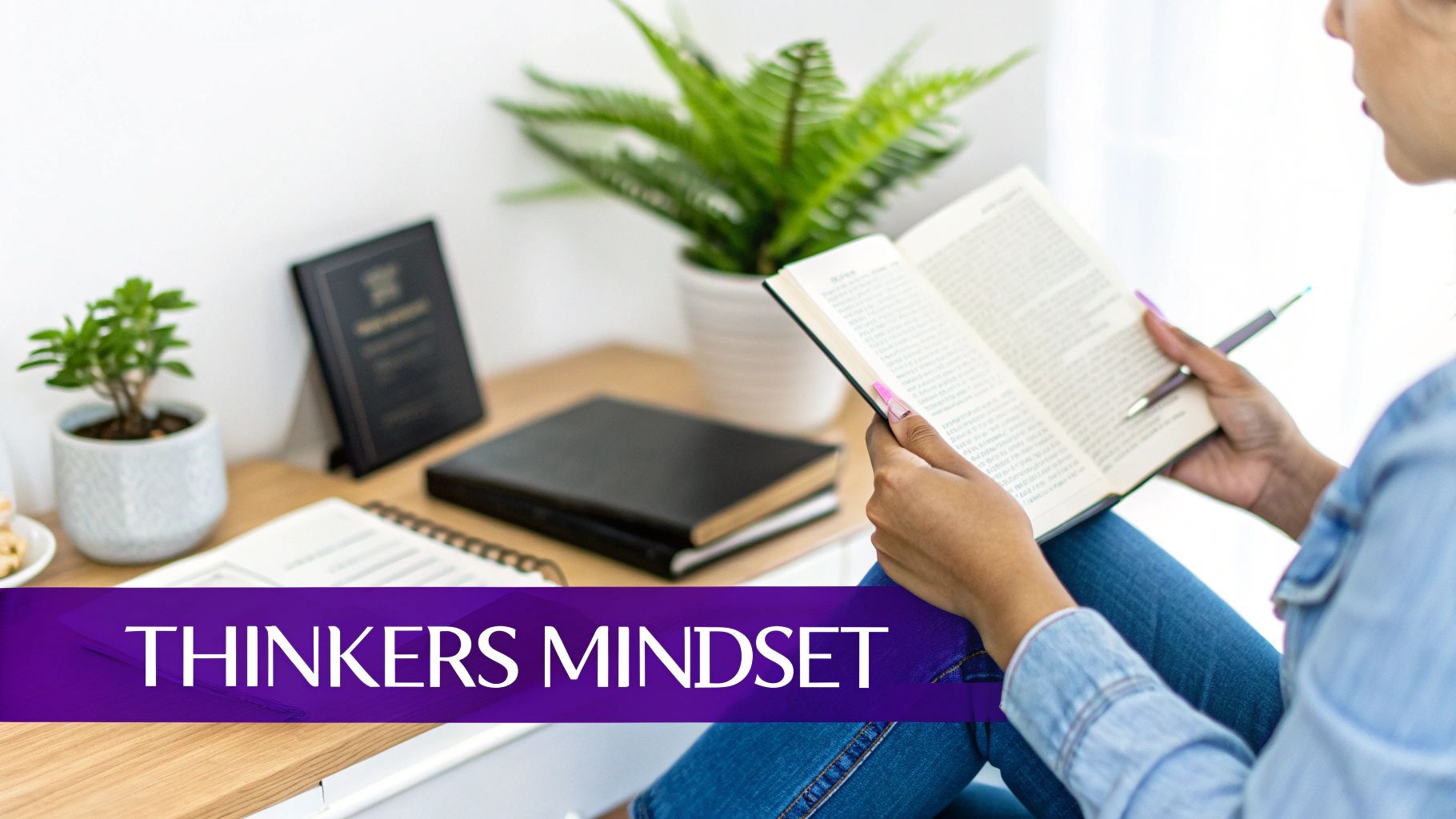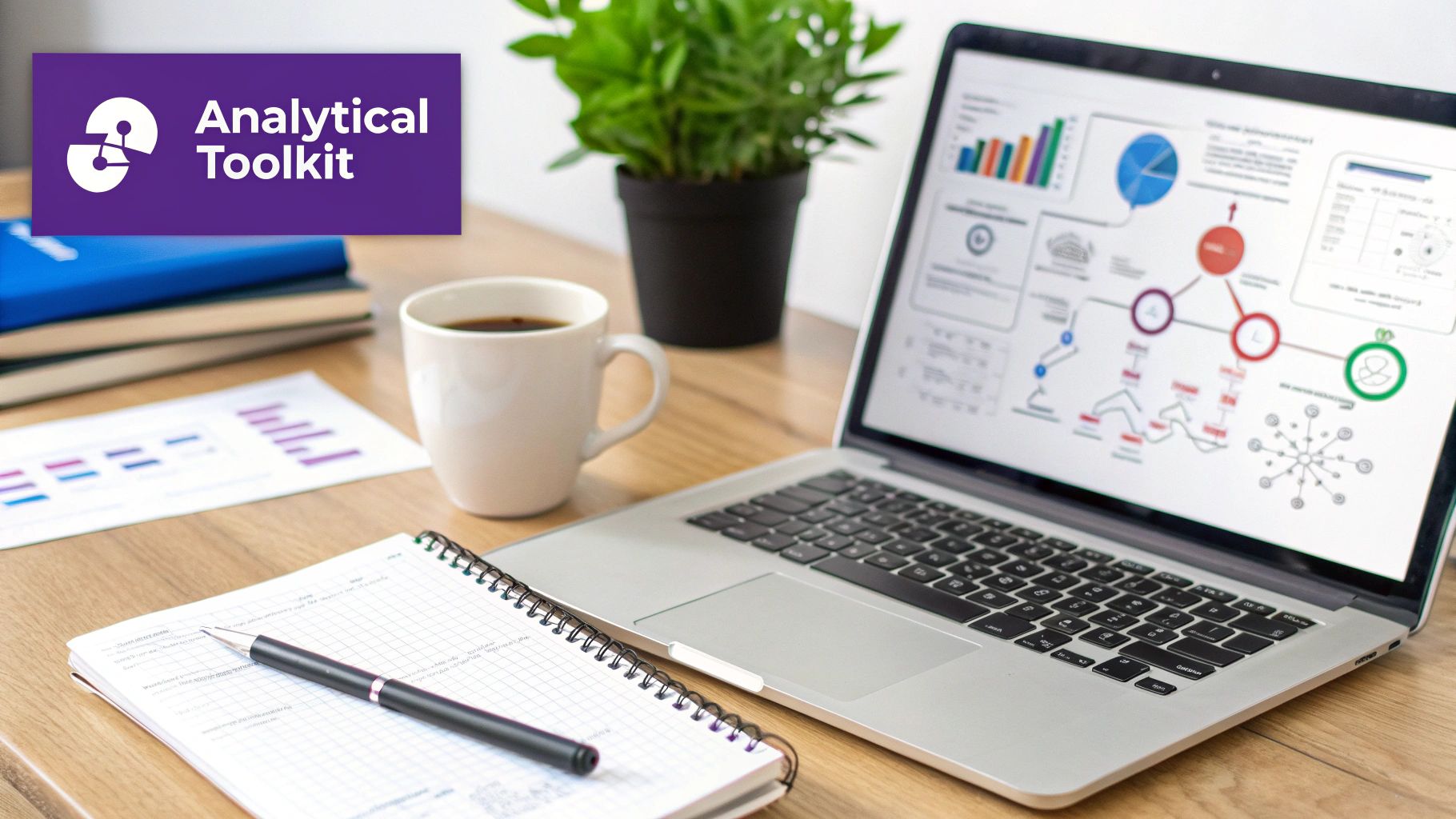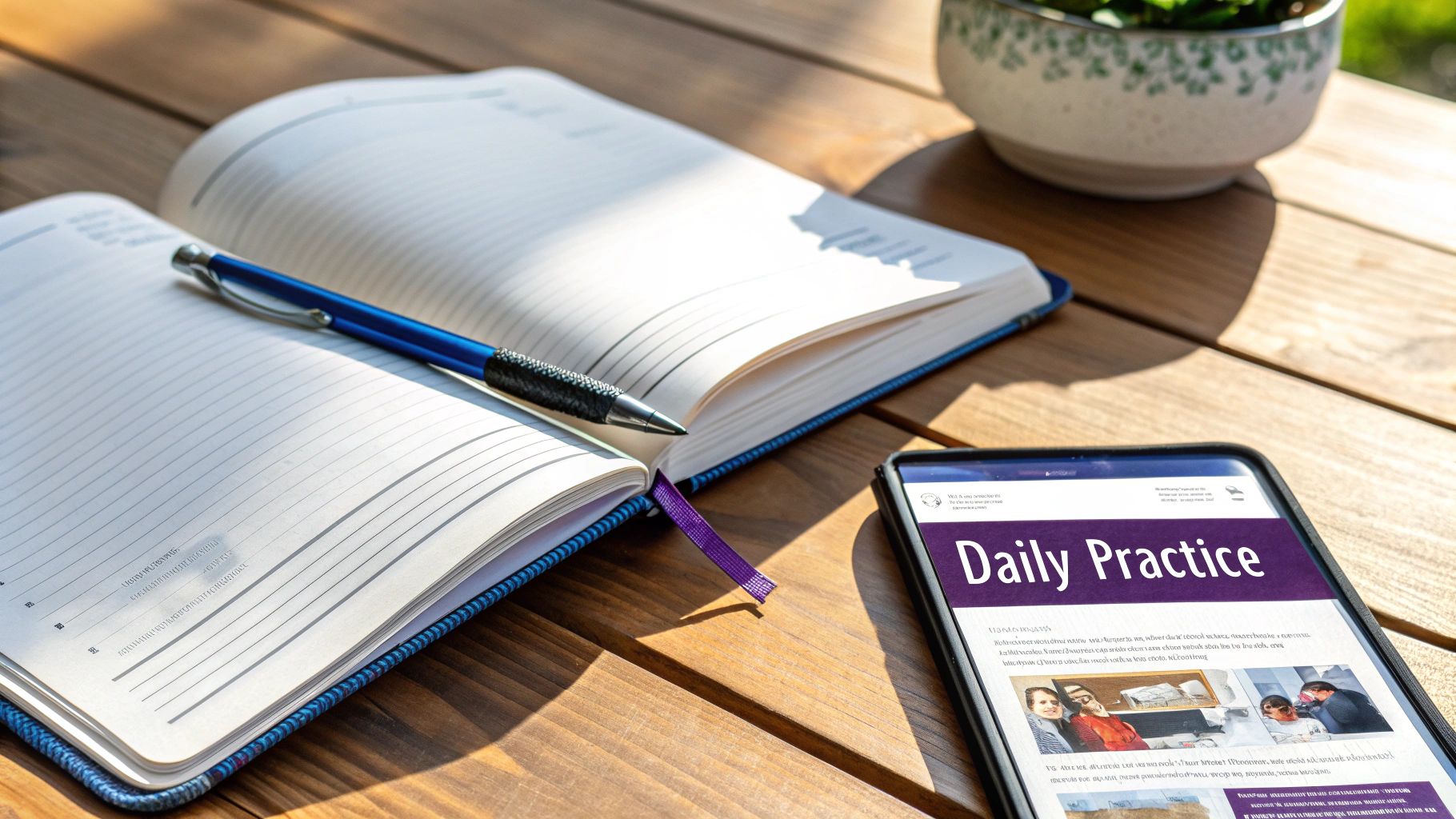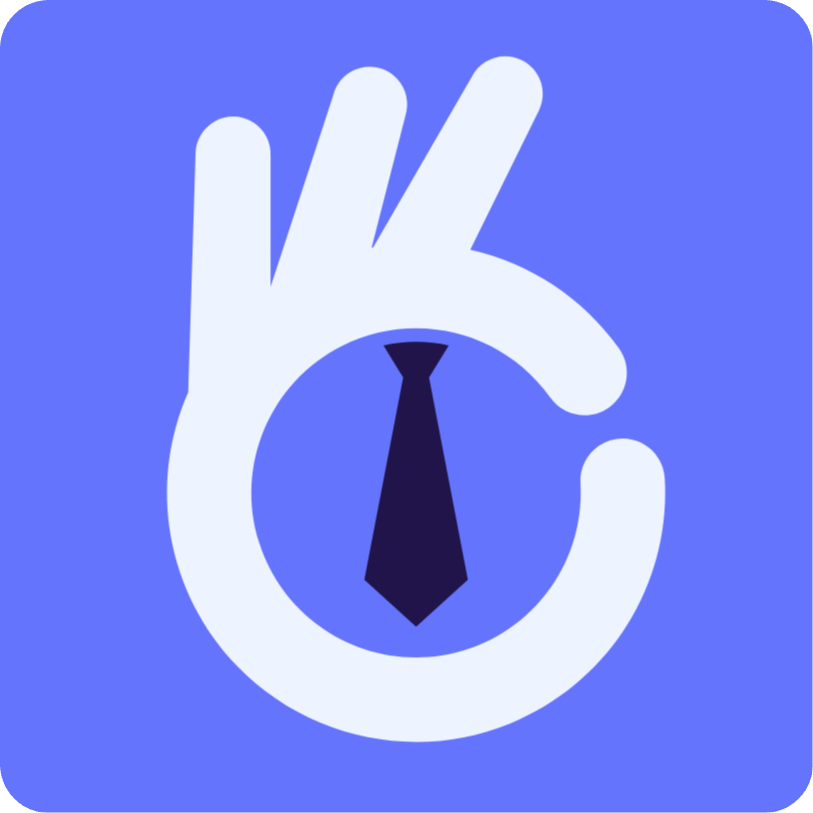How to Develop Critical Thinking Skills That Matter
To really develop critical thinking, you have to do more than just passively absorb information. It's an active process—you have to question assumptions, evaluate arguments, and draw conclusions based on reason. It's a disciplined way of thinking that guides what you believe and how you act.
Why Critical Thinking Is Your Most Valuable Skill

We live in a world overflowing with information. Every single day, you're hit with a firehose of data, opinions, and ads trying to sway your decisions. Without a good filter, it's incredibly easy to get swept away.
Critical thinking is that filter. It’s what lets you pause, really look at the information you're given, and make a call based on logic and evidence—not just gut feelings or what everyone else is saying.
The Real-World Impact of Poor Thinking
Think about the real-world consequences when this skill is missing. Sophisticated online scams work precisely because they exploit our inability to spot a shaky argument. People pour their life savings into questionable investments based on social media hype, only to face devastating losses.
In the workplace, it’s just as crucial. I’ve seen projects fail and resources get torched simply because no one on the team stopped to question the initial assumptions. These aren't just abstract ideas; they're everyday situations where the ability to dissect an argument is the difference between a win and a big loss.
The Surprising Skill Gap We All Face
Here's the strange part: for something so important, most of us were never actually taught how to think critically. We were expected to just pick it up along the way, almost by osmosis.
And this isn't just a hunch. A 2020 global survey from the REBOOT Foundation found that while 94% of people believe critical thinking is 'extremely' or 'very important,' a huge 86% felt the general public was lacking in this area. Even more telling? 60% said they never got any formal training on the subject in school. You can dive into the full findings yourself by reading the study on the state of critical thinking.
This isn't some high-minded skill reserved for academics or scientists. It's a practical, everyday tool for making better choices, whether you're figuring out your next career move, reading a news story, or just trying to understand someone else's point of view.
Ultimately, learning to think critically is about taking control of your own mind. It’s about building a mental framework that helps you:
- Identify and challenge assumptions—both your own and others'.
- Recognize biases that can cloud judgment.
- Evaluate evidence to separate the credible stuff from the noise.
- Formulate coherent arguments so you can express your ideas clearly.
By sharpening these skills, you stop being a passive consumer of information and become an active participant in your own life. You gain the ability to make decisions with confidence and clarity. The rest of this guide will give you the actionable strategies to get there.
Build Your Foundation with a Thinker's Mindset

Before you can get into the weeds with complex mental models and analytical frameworks, you have to build the right foundation. Learning critical thinking isn't about memorizing a checklist; it's about shifting your entire mindset. This internal framework is what governs how you approach every new piece of information and every challenge that comes your way.
Without this mindset, even the best techniques will feel clunky and unnatural. It’s like trying to follow a recipe with the wrong ingredients versus truly understanding how flavors work together. This shift is what turns you from a passive consumer of information into an active, engaged thinker.
Embrace Intellectual Humility
The real starting point for any genuine learning is admitting the limits of your own knowledge. Intellectual humility isn't about putting yourself down. It's about having the self-awareness to confidently say, "I don't know, but I'm ready to find out."
This means being genuinely open to the idea that your long-held beliefs might be incomplete or just plain wrong. It’s a tough pill to swallow, but it’s absolutely essential. When you finally accept you don’t have all the answers, you create the space for new, better information to come in.
True intellectual humility isn't about how much you know. It's about being profoundly aware of what you don't know and being genuinely eager to close that gap.
To start practicing this, try asking yourself a few simple questions whenever you encounter a strong opinion—especially your own:
- What evidence out there could challenge this belief?
- What personal experiences have shaped my view on this?
- How might someone from a completely different background see this issue?
This habit of self-reflection is a core part of any good professional development planning strategy here. By spotting the gaps in your own understanding, you can strategically build the skills you need to grow.
Cultivate Genuine Curiosity
Once you’ve acknowledged what you don't know, the next move is to actively want to fill those gaps. Curiosity is the engine that drives critical thinking. It's that nagging desire to look past the surface level and start asking the powerful, probing questions.
An undisciplined mind just follows random thoughts—"this reminds me of that." A curious, disciplined mind, on the other hand, follows logical threads—"if this is true, then what else does that imply?" It's all about moving from passive observation to active investigation.
For instance, instead of just accepting a news headline at face value, a curious mind immediately asks:
- Who wrote this, and what's their angle?
- What data is this conclusion actually based on?
- What crucial context is being left out of this story?
You don't need to spend hours researching every little thing. It's about nurturing a habit of questioning information by default.
Develop Intellectual Courage
The final piece of a thinker's mindset is often the most difficult: intellectual courage. This is your willingness to fairly consider ideas, beliefs, or viewpoints that you might personally find absurd, offensive, or even dangerous.
Our brains are hardwired to protect our existing worldview. It’s deeply uncomfortable to engage with ideas that threaten our sense of identity or the group we belong to. But intellectual courage means pushing right through that discomfort for the sake of getting closer to the truth.
Here’s a practical challenge to help you build this muscle:
- Find a Source: Go find a well-written article or opinion piece from a publication or an author you fundamentally disagree with.
- Analyze the Logic: Read it with one goal: to understand the author's argument, not to refute it. Map out their main points and the evidence they're using.
- Summarize Fairly: Try to explain their position to a friend in a way that the original author would agree is a fair and accurate representation.
This exercise forces you to separate an argument's logic from your emotional reaction to it. It’s an incredibly powerful way to see that even ideas you oppose have an internal structure worth understanding. Adopting these three pillars—humility, curiosity, and courage—is what creates the fertile ground where sharp analytical skills can finally take root and grow.
Your Toolkit for Sharper Analysis

Having the right mindset is the foundation, but to really start making better decisions, you need some practical tools. This is where mental models come in. Think of them as frameworks for your brain—they turn a fuzzy goal like "think better" into a concrete, repeatable process.
These aren't just academic theories. They're practical lenses you can use to look at a problem from different angles, helping you dissect challenges and make choices with way more clarity. Let's get a few of these into your toolkit right now.
The RED Model for Everyday Decisions
One of the most useful and easy-to-remember frameworks is the RED Model. It’s a simple, three-step gut check for any claim, proposal, or situation you face.
- R – Recognize Assumptions: What’s being taken for granted here? What has to be true for this argument to even stand up?
- E – Evaluate Arguments: Now, you dig into the evidence. Is the logic solid? Is the data they're presenting actually relevant and reliable?
- D – Draw Conclusions: After weighing everything, you form a reasoned judgment. This isn’t a gut feeling; it’s a conclusion that flows directly from what you’ve just analyzed.
Let's see how this works in a real-world business scenario. Imagine a team wants to buy new project management software, promising it will boost productivity by 25%.
Using the RED model, you first Recognize Assumptions. The big one is that the current software is the main thing holding productivity back. Another is that everyone will adopt the new tool easily, with no major hiccups or learning curve.
Next, you Evaluate Arguments. Where did that 25% number come from? You'd ask to see the data. Is it from a case study with a company just like yours, or is it just a marketing slogan? This is where critically evaluating your sources becomes so important—you need to check for bias and credibility.
Finally, you Draw a Conclusion. You might decide that while the software looks promising, the 25% claim feels overblown. A smart conclusion might be to run a small pilot program with one team to get your own data before rolling it out to the entire company.
Dig Deeper with the Five Whys
Sometimes, the problem you're looking at is just a symptom of something much bigger. The Five Whys technique is a simple but powerful way to get to the root cause of an issue. You just state the problem and ask "Why?" about five times, drilling down with each answer.
Let’s take a classic project management headache: "The marketing report was delivered late."
- Why was it late? The data from the sales team didn't arrive on time.
- Why was the sales data late? The sales manager had to pull it all together manually from a dozen different spreadsheets.
- Why did it have to be done manually? The CRM software we use doesn't have an automated report for that specific metric.
- Why don't we have that feature? It’s part of a premium subscription tier we decided not to buy.
- Why didn't we buy that tier? The initial budget review decided it was an "unnecessary" expense.
Boom. In five questions, the problem isn’t about a "late marketing team" anymore. It's about a systemic budgeting decision made months ago. The real fix isn't just to scold someone for being late; it's to re-evaluate the tools you're giving your team. Visualizing workflows and roadblocks like this can be a game-changer, something a personal Kanban board can help with.
Master Second-Order Thinking
First-order thinking is all about the immediate result. It's fast, easy, and often gets us into trouble. Second-order thinking is more disciplined. It forces you to ask, "And then what?" It’s the art of thinking through the consequences of the consequences.
Let's say you're considering a new job offer.
A first-order thinker sees the immediate perks: a bigger salary and a more impressive title. A second-order thinker maps out the ripple effects:
- Immediate Consequence: Higher salary.
- Second-Order Consequence: That higher salary could push you into a new tax bracket and lead to lifestyle inflation, so you don't actually feel any richer. The new role might also demand 60-hour weeks, leaving you with no time or energy to enjoy that extra income.
So many of our worst decisions come from failing to consider these long-term effects. This skill is about moving past the shiny, initial outcome and tracing the chain of events that will likely follow.
To make these frameworks even easier to grab and use, here’s a quick summary of the models we’ve covered.
Three Actionable Critical Thinking Models
| Mental Model | Best Used For | Key Question to Ask |
|---|---|---|
| The RED Model | Evaluating proposals, claims, or arguments in a structured way. | What's the core assumption, is the evidence solid, and what conclusion does it support? |
| The Five Whys | Finding the true root cause of a recurring problem, not just the symptom. | Why did that happen? (And repeat until you hit the real issue). |
| Second-Order Thinking | Making major decisions with long-term implications (career, finance, strategy). | And then what happens? What are the consequences of that consequence? |
By practicing these models, you’re not just learning theory—you’re actively building the mental muscles for sharper, clearer, and more effective thinking in your everyday life.
Practice Daily Critical Thinking Exercises

Here’s the thing about great thinkers: they weren't just born that way. They got there through practice. All the mental models and frameworks in the world are useless unless you actually use them. The goal is to make critical thinking less of a stuffy academic concept and more of a daily habit, something you do without even thinking about it.
You don't need to block off hours on your calendar for this. The best way to build this mental muscle is by weaving it into things you're already doing—reading the news, chatting with a friend, or even just scrolling through your feed.
Let's break down a few simple, high-impact exercises you can start doing today.
Deconstruct Your Daily News
Every article you read is a chance to train your brain. Instead of just letting the words wash over you, try turning your reading time into an active exercise. Next time you open a news story, take an extra five minutes to do a quick deconstruction.
This isn't about agreeing or disagreeing with the writer. It's about looking under the hood at how their argument is built.
- Spot the Bias: What's the author's angle here? Are they using loaded, emotional words like "disastrous" or "miraculous," or are they keeping the language neutral and fact-based?
- Check the Sources: Look at what they're citing. Is it specific data and named experts, or vague hand-waving like "studies show" or "it is widely believed"?
- Find the Core Argument: If you had to boil it down, what's the one thing the author is trying to convince you of? What are the key pieces of evidence they use to back it up?
Do this consistently, and you'll start to automatically question information instead of just passively accepting it. You shift from being a consumer to an analyst.
Keep an Assumption Journal
We all walk around with a thick layer of unexamined assumptions. These are the beliefs we accept as "obvious" without a second thought, and they quietly drive our decisions all day long. An Assumption Journal is a powerful, five-minute daily habit that drags these hidden beliefs into the spotlight.
It's dead simple. Every day, just pinpoint one assumption you made. It can be about anything, big or small.
- "I assumed traffic would be fine, so I left for my meeting late."
- "I assumed my boss would hate this idea, so I never brought it up."
- "I assumed this project would be a piece of cake, but it's way more complex than I thought."
Write it down. Then, ask two simple questions: "Why did I believe that?" and "What actual evidence did I have?" More often than not, you'll find your assumptions are built on old habits, feelings, or just inertia. This exercise doesn't just show you your mental shortcuts; it gives you the power to choose whether to take them.
By consistently questioning one small belief each day, you build the habit of challenging the bigger, more impactful assumptions that shape your career, relationships, and worldview.
Use Socratic Questioning in Conversations
You can even sharpen your critical thinking skills while just talking to people. The Socratic method isn’t about being argumentative or trying to "win" a conversation. It's about a shared journey of discovery through questioning.
Instead of just nodding along, you can gently probe for more clarity and depth. This forces both you and the person you're talking with to think more carefully about what you really believe.
Try sprinkling a few of these questions into your next chat:
- For Clarity: "When you say
[insert term], what exactly do you mean by that?" - To Challenge Assumptions: "What are we assuming to be true here?"
- For Evidence: "Can you give me an example of that?" or "What led you to that conclusion?"
- To Explore Consequences: "If we accept that, what are the implications for…?"
When you use these questions respectfully, a normal conversation transforms into a mutual exploration of an idea. You’re not trying to poke holes in their argument; you’re trying to understand it on a deeper level. It’s a practice that not only strengthens your own analytical abilities but leads to much more interesting and productive conversations.
Learning to Spot—and Sidestep—Common Thinking Traps
Look, even the sharpest minds fall into mental traps. Our brains are built for efficiency, which means they love taking shortcuts. These shortcuts, known as cognitive biases, are great for navigating day-to-day life without overthinking every little thing. But when you’re staring down a complex problem, they can completely derail clear, logical thinking.
Developing real critical thinking skills is about learning to spot these traps in real time. It's like becoming a detective of your own mind, constantly asking why you're leaning toward a certain conclusion. Once you pull back the curtain on these common biases, you can start to counteract them and make far more reasoned decisions.
The Echo Chamber of Confirmation Bias
We’ve all been there. Confirmation bias is that all-too-human tendency to seek out, interpret, and remember information that proves what we already believe. It’s comfortable. It feels good to have our worldview validated. The problem? That comfort often comes at the expense of the truth.
Think about how you scroll through your newsfeed. Do you gravitate toward sources that echo your political or social views? Do you zoom right past articles that might challenge your perspective? That’s confirmation bias doing its thing. It builds an echo chamber where your existing beliefs are amplified and opposing views are never given a fair shake.
How to Break Out:
You have to make a conscious effort to engage with viewpoints that make you uncomfortable. This isn’t about being convinced to change your mind; it’s about genuinely understanding the logic on the other side.
- Your Action Plan: Once a week, pick a topic you feel strongly about. Then, find a well-researched article from a source you’d normally avoid. The goal isn't to agree. It's to simply map out the author's argument. What are their key points? What evidence are they using? This one simple exercise forces you out of your bubble.
Getting Skewed by the Availability Heuristic
The availability heuristic is a sneaky mental shortcut where we judge the likelihood of an event based on how easily an example comes to mind. Vivid, emotional, or recent memories feel more significant, so we give them more weight than they deserve.
This is exactly why hearing about a single shark attack on the news makes you feel like shark attacks are a common threat, even though they are statistically incredibly rare. The dramatic story sticks in your brain, warping your perception of risk.
A dramatic, easily recalled event can hijack our entire perception of risk. We start making decisions based on headlines and fear, not on actual data.
How to Fight It:
When you’re making a judgment call, hit the pause button. Ask yourself, "Am I basing this on a recent, vivid story, or am I looking at the broader data?" Force yourself to seek out the statistics, not just the sensational headline. This pushes you past your brain's lazy first instinct and toward a much more accurate assessment.
The "Too Invested to Quit" Sunk Cost Fallacy
Have you ever stuck with a project, a job, or even a bad movie just because you’d already put so much time, money, or effort into it? That’s the sunk cost fallacy in action. It’s our totally irrational reluctance to abandon ship because of the investment we've already made—even when it's painfully obvious that cutting our losses is the smartest move.
A classic example is the business leader who keeps pouring money into a failing project. The thinking goes, "We can't stop now; we've already spent millions!" But that money is gone. It's a "sunk" cost. The only question that matters is whether future investment makes sense, completely independent of past spending.
How to Overcome It:
Reframe the decision so you’re only looking forward. Ask yourself one brutally honest question: "If I weren't already invested in this, would I choose to get involved today?" If the answer is no, that's a massive red flag that the sunk cost fallacy has its hooks in you. Make your next move based on future potential, not past expenses.
Why We Have to Teach Ourselves to Think
Getting past these biases takes deliberate, consistent practice, yet you’d be surprised how rarely these skills are formally taught. It's a systemic issue. A 2025 OECD working paper dug into higher education policies and found a huge disconnect. While national guidelines talk a big game about the importance of critical thinking, those skills are almost never built into actual system-level assessments.
The takeaway? Despite good intentions, the institutional muscle needed to build these mental habits just isn’t there. You can dig into the full findings on this assessment gap on oecd.org.
This gap is precisely why a personal commitment to hunting down and overcoming your own thinking traps is so critical. We can't wait for a formal system to train us. More often than not, the responsibility is on us to build these skills ourselves, one bias at a time. By understanding these common mental traps, you’re taking the first—and most important—step toward clearer, sharper thinking.
Putting It All Together for Better Decisions
So, where do we go from here? Getting better at critical thinking isn’t like finishing a course or memorizing a list of biases. It’s a practice, something you weave into your everyday life.
All the skills and mental models we’ve covered are designed to become your new default setting for tackling problems. The goal isn't to pull out a clunky checklist for every decision. It's to get to a point where your brain just naturally starts questioning assumptions and spotting weak arguments.
Making Critical Thinking a Real Habit
Real growth comes from putting in the reps, consistently. You can’t get strong from one trip to the gym, and you can’t sharpen your mind with a single analytical exercise. It's all about creating a sustainable loop of practice, reflection, and real-world application.
Be patient with yourself. Some days, you’ll slip back into old habits or fall for a cognitive bias. It happens. The point is progress, not perfection. Honestly, just recognizing a mental misstep after it happens is a huge win.
The real magic happens when critical thinking stops being a tool you occasionally use and becomes the operating system for your mind—the lens through which you see everything.
To make this stick, start small. Pick one thing. Maybe it’s keeping an Assumption Journal or using the Five Whys on a nagging problem at work. Do that for a few weeks until it feels automatic, then add something new.
A Quick Framework for Big Decisions
When you’re facing a major choice, you need a simple way to bring all these ideas together. Before you pull the trigger, just pause and run through a few quick questions.
- Mindset Check: Am I actually open to being wrong here, or am I just looking for things that confirm what I already think?
- Model Application: Which mental model is the best fit? Do I need to dig for a root cause (Five Whys) or think about the long-term ripple effects (Second-Order Thinking)?
- Bias Scan: What mental shortcuts might be tripping me up? Am I sticking with something just because I've already invested so much time in it (sunk cost fallacy)?
This doesn't have to be a long, drawn-out process. A focused ten-minute reflection can save you from a decision you’ll kick yourself for later.
For example, plotting out a career path requires exactly this kind of strategic thinking; using a good career development plan template can give your thoughts the structure they need. The same goes for building a powerful business portfolio—it’s all about making sound judgments backed by sharp analysis.
Ultimately, this whole journey is about shifting from knee-jerk reactions to deep, proactive analysis. By committing to the practice, you’re not just learning a new skill. You’re equipping yourself to make smarter choices and navigate a complex world with a lot more confidence.
Got Questions About Critical Thinking?
As you start pulling these threads and thinking more critically, it's natural for a few questions to pop up. Let's tackle some of the most common ones I hear.
Can You Really Learn to Be a Better Thinker?
You bet. Some people might seem like they were born with a knack for it, but critical thinking is a skill, not a fixed trait. It’s like a muscle.
By learning how the mind works, intentionally practicing a few exercises, and being honest about your own biases, anyone can build up their ability to think with more clarity and logic.
But How Do I Practice If I Have No Time?
Good news: you don't need to block off an hour for "deep thinking." The best way is to weave it into what you’re already doing.
- Reading a news story? Take an extra 30 seconds to ask, "Who's behind this, and what's their angle?"
- In a meeting and a coworker makes a bold claim? Mentally check yourself: "What's the evidence for that?"
These small, consistent check-ins add up way faster than a once-a-month cram session.
Critical thinking is driven by curiosity, not cynicism. The aim isn't to poke holes in every idea, but to truly understand them and find the most solid path forward.
Won't This Just Make Me Seem Negative or Argumentative?
Not if you approach it the right way. When you practice critical thinking with a bit of humility, it actually leads to better conversations, not more arguments.
It's about asking genuine questions to understand things better and evaluating ideas respectfully. The goal is to get to the truth together, not to win a debate.
Ready to apply that sharp thinking to your job search? Eztrackr is built to help you organize your applications, break down job descriptions for the skills that matter, and see your progress at a glance. It lets you focus on what's important. Start managing your job hunt intelligently today.
 Interview Sidekick
Interview Sidekick